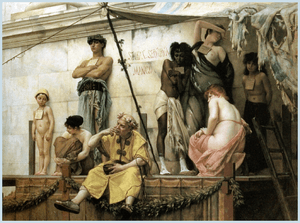The Slave Market (Boulanger painting)
The Slave Market is a painting of about 1882 by the 19th century French artist Gustave Boulanger, who specialized in classical and Orientalist genre scenes.[1] It depicts an Ancient Roman slave auction. It shows the marketing of seven young people, ranging in age from children to young adults, as slaves. Both male slaves, as well as three of the female slaves, bear a similarity in appearance perhaps suggesting that they are members of a family forced into slavery by economic conditions. All are wearing tags to indicate their availability as slaves. The youngest boy is completely naked, while the young man next to him is wearing a loincloth. The young woman sitting next to them is topless, wearing only a skirt, but she is covering her breasts with her legs in a protective pose. The standing African woman is also topless, wearing a white loincloth, and she is covering her breasts with her hands. Her feet are whitened with chalk to show she is a foreign import, unlike the others, and tax has been paid on her.[2] The taller, standing, young woman is wearing a translucent garment which clearly shows her breasts and pubic hair—she is trying to shield her eyes, perhaps because her potential buyers include former friends and neighbors, who are probably seeing her nude for the first time. The adolescent girl next to her is also topless and barefoot, wearing a skirt. The red haired woman crouching next to them is wearing a loose garment which leaves both her breasts and her genitals exposed. The auctioneer sits eating his lunch with a very casual attitude.
| The Slave Market | |
|---|---|
 | |
| Artist | Gustave Boulanger |
| Year | circa 1882 |
| Medium | Oil on canvas |
| Location | Private Collection |
From a common type of Salon academic art of the period, it depicts an eroticized scene clad as a history painting, as was customary at the time in Paris. Boulanger had visited Italy, Greece, and North Africa, and the painting reflects his attention to culturally correct details and skill in rendering the female form.[3]
References
- Masler, 39
- Smith, William (1875). A Dictionary of Greek and Roman Antiquities. London: John Murray. p. 1040.
- Masler, Marilyn (2009). "Embracing the Academic Tradition". In Masler, Marilyn; Pacini, Marina (eds.). Carl Gutherz: Poetic Vision and Academic Ideals. Jackson, Tennessee: University Press of Mississippi. pp. 38–39. ISBN 978-0-915525-11-9.